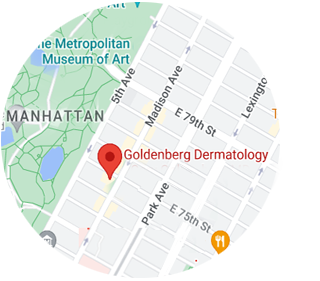
However, this does not mean it can be left untreated. Our top NYC board-certified dermatologists Doctors Gary and Kristina Goldenberg have seen many cases of skin cancer, including basal cell carcinoma, melanoma, and squamous cell carcinoma. Treatment is successful for patients who are diagnosed early and less successful for those who ignore their symptoms. Any suspicion of skin cancer must be taken seriously and properly examined by a board-certified dermatologist.
CA– USES OF BASAL CELL CARCINOMA
Basal cell carcinoma arises due to cellular damage. A major cause of damage to basal cell DNA is excessive or chronic exposure to ultraviolet radiation (UV), which is found in sunlight and tanning lamps and beds. In cases in which cancer develops in areas of the skin not generally exposed to sunlight, other factors, such as a compromised immune system, may be contributing to the risk of basal cell carcinoma.
Signs and Symptoms of Basal Cell Carcinoma
Because basal cell carcinoma is the result of chronic ultraviolet radiation exposure, symptoms usually appear in areas that receive the most sunlight, such as the face, ears, neck, scalp, shoulder and back. Some tell-tale signs that a spot on your skin might be a basal cell carcinoma include:
- Open sore. A sore that bleeds easily and does not heal may point to skin cancer. The sore may have oozing, as well as crusting spots.
Reddish patch. A flat, scaly, reddish, or brown patch can be a common symptom. Such patches often appear on the back or chest and can grow quite large. - Shiny bump or nodule. These translucent, pearly bumps, usually found on the neck and head, can cause discomfort and may tend to bleed after a minor injury.
- Pink growth. A slightly dome-shaped raised bump, marked with irregular, visible blood vessels should be cause for concern. These growths often present on the face, ears, or neck.
- Eczema lesion or scars. Lesions that tend to bleed and maybe itchy and scar-like sores that appear without any associated injury could indicate basal carcinoma. If the scar is white and waxy, it could be a sign of a rare, more damaging form of cancer.
Treatments for Basal Cell Carcinoma in NYC
The most common form of cancer in the United States, basal cell carcinoma is highly treatable. When detected and addressed early, most basal cell cancers can be cured. Although some basal cancers may recur, smaller ones are less likely to return. Some common treatment options include:
- Surgical excision. In this procedure, the cancerous tissue and a small amount of neighboring healthy tissue are carefully excised. This option is often used to treat large basal cell carcinoma.
- Electrodessication and curettage. In this procedure, the tissue is anesthetized and then the tumor cells are scraped out and an electric needle is used to treat the base of the lesion.
- Mohs surgery. In this procedure, the abnormal cancer cells are removed layer by layer, while minimizing the removal of surrounding normal skin tissue. This treatment option is useful on recurrent basal cell carcinomas and deep, fast-growing types that generally appear on the face.
- Oral medication. New oral medication that inhibits the growth of basal cells are currently available to treat this cancer. These medications are approved to treat advanced or metastatic disease. Although some less advanced tumors can also be treated.











